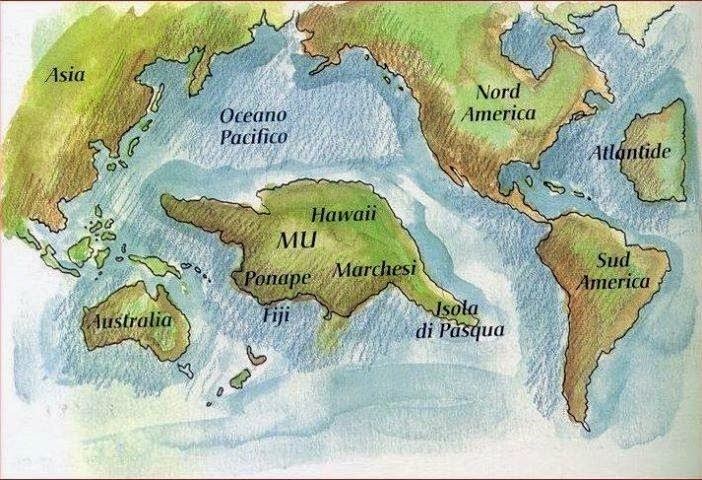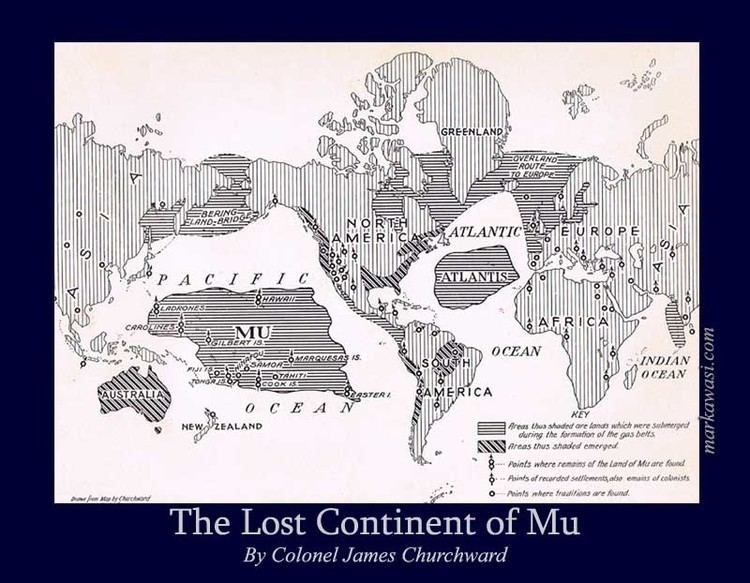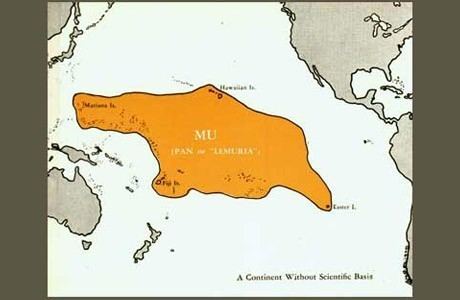 | ||
Type Hypothetical lost continent | ||
Mu is the name of a suggested lost continent whose concept and name were proposed by 19th-century traveler and writer Augustus Le Plongeon, who claimed that several ancient civilizations, such as those of Egypt and Mesoamerica, were created by refugees from Mu—which he located in the Atlantic Ocean. This concept was popularized and expanded by James Churchward, who asserted that Mu was once located in the Pacific.
Contents
- Augustus Le Plongeon
- James Churchward
- Modern claims
- Geological arguments
- Archaeological and genetic evidence
- Troano Codex
- In popular culture
- References

The existence of Mu was already being disputed in Le Plongeon's time. Today scientists dismiss the concept of Mu (and of other alleged lost continents such as Lemuria) as physically impossible, arguing that a continent can neither sink nor be destroyed in the short period of time required by this premise. Mu's existence is now considered to have no factual basis.

Augustus Le Plongeon
The mythical idea of Mu first appeared in the works of Augustus Le Plongeon (1825–1908), after his investigations of the Maya ruins in Yucatán. He claimed that he had translated ancient Mayan writings which supposedly showed that the Maya civilization of the Yucatán was older than those of Greece and Egypt, and told the story of an even older continent.

Le Plongeon actually got the name "Mu" from Charles Étienne Brasseur de Bourbourg, who in 1864 mistranslated what was then called the Troano Codex using the de Landa alphabet. Brasseur believed that a word which he read as Mu referred to a land which had been submerged by a catastrophe. Le Plongeon then identified this lost land with Atlantis, and turned it into a continent which had supposedly sunk into the Atlantic Ocean:
In our journey westward across the Atlantic we shall pass in sight of that spot where once existed the pride and life of the ocean, the Land of Mu, which, at the epoch that we have been considering, had not yet been visited by the wrath of Human, that lord of volcanic fires to whose fury it afterward fell a victim. The description of that land given to Solon by Sonchis, priest at Sais; its destruction by earthquakes, and submergence, recorded by Plato in his Timaeus, have been told and retold so many times that it is useless to encumber these pages with a repetition of it.
Le Plongeon claimed that the civilization of ancient Egypt was founded by Queen Moo, a refugee from the land's demise. Other refugees supposedly fled to Central America and became the Maya.
James Churchward
Mu, as a lost Pacific Ocean continent, was later popularised by James Churchward (1851–1936) in a series of books, beginning with Lost Continent of Mu, the Motherland of Man (1926), re-edited later as The Lost Continent Mu (1931). Other popular books in the series are The Children of Mu (1931), and The Sacred Symbols of Mu (1933).
Churchward claimed that "more than fifty years ago", while he was a soldier in India, he befriended a high-ranking temple priest who showed him a set of ancient "sunburnt" clay tablets, supposedly in a long lost "Naga-Maya language" which only two other people in India could read. Having mastered the language himself, Churchward found out that they originated from "the place where [man] first appeared—Mu". The 1931 edition states that "all matter of science in this work are based on translations of two sets of ancient tablets": the clay tables he read in India, and a collection of 2,500 stone tablets that had been uncovered by William Niven in Mexico.
Churchward gave a vivid description of Mu as the home of an advanced civilization, the Naacal, which flourished between 50,000 and 12,000 years ago, was dominated by a “white race", and was "superior in many respects to our own". At the time of its demise, about 12,000 years ago, Mu had 64,000,000 inhabitants and many large cities, and colonies on the other continents.
Churchward claimed that the landmass of Mu was located in the Pacific Ocean, and stretched east–west from the Marianas to Easter Island, and north–south from Hawaii to Mangaia. He claimed that according to the creation myth he read in the Indian tablets, Mu had been lifted above sea level by the expansion of underground volcanic gases. Eventually Mu "was completely obliterated in almost a single night": after a series of earthquakes and volcanic eruptions, "the broken land fell into that great abyss of fire" and was covered by "fifty millions of square miles of water."
Churchward claimed that Mu was the common origin of the great civilizations of Egypt, Greece, Central America, India, Burma and others, including Easter Island, and was in particular the source of ancient megalithic architecture. As evidence for his claims, he pointed to symbols from throughout the world, in which he saw common themes of birds, the relation of the Earth and the sky, and especially the Sun. Churchward claims that the king of Mu was named Ra and he relates this to the Egyptian god of the sun, Ra, and the Rapa Nui word for Sun, ra’a, which he incorrectly spells "raa." He claimed to have found symbols of the Sun in "Egypt, Babylonia, Peru and all ancient lands and countries – it was a universal symbol."
Churchward attributed all megalithic art in Polynesia to the people of Mu. He claimed that symbols of the sun are found "depicted on stones of Polynesian ruins", such as the stone hats (pukao) on top of the giant moai statues of Easter Island. Citing W.J. Johnson, Churchward describes the cylindrical hats as "spheres" that "seem to show red in the distance", and asserts that they “represent the Sun as Ra.” He also incorrectly claimed that some of them are made of "red sandstone", which does not exist on the island. The platforms on which the statues rest (ahu) are described by Churchward as being "platform-like accumulations of cut and dressed stone", which were supposedly left in their current positions "awaiting shipment to some other part of the continent for the building of temples and palaces". He also cites the pillars "erected by the Māori of New Zealand" as an example of this lost civilization's handiwork. In Churchward's view, the present-day Polynesians are not descendants of the dominant members of the lost civilization of Mu, responsible for these great works, but are instead descendants of survivors of the cataclysm that adopted "the first cannibalism and savagery" in the world.
Modern claims
James Bramwell and William Scott-Elliott claimed that the cataclysmic events on Mu began 800,000 years ago and went on until the last catastrophe, which occurred in precisely 9564 BC.
In the 1930s, Atatürk, founder of the Turkish Republic, was interested in Churchward's work and considered Mu as a possible location of the original homeland of the Turks.
Masaaki Kimura has suggested that certain underwater features located off the coast of Yonaguni Island, Japan (popularly known as the Yonaguni Monument) are ruins of Mu (or "ruins of the lost world of Muin" according to CNN).
Geological arguments
Modern geological knowledge rules out "lost continents" of any significant size. According to the theory of plate tectonics, which has been extensively confirmed over the past 40 years, the Earth's crust consists of lighter "sial" rocks (continental crust rich in aluminium silicates) that float on heavier "sima" rocks (oceanic crust richer in magnesium silicates). The sial is generally absent in the ocean floor where the crust is a few kilometers thick, while the continents are huge solid blocks tens of kilometers thick. Since continents float on the sima much like icebergs float on water, a continent cannot simply "sink" under the ocean.
It is true that continental drift and seafloor spreading can change the shape and position of continents and occasionally break a continent into two or more pieces (as happened to Pangaea). However, these are very slow processes that occur in geological time scales (hundreds of millions of years). Over the scale of history (tens of thousands of years), the sima under the continental crust can be considered solid, and the continents are basically anchored on it. It is almost certain that the continents and ocean floors have retained their present position and shape for the whole span of human existence.
There is also no conceivable event that could have "destroyed" a continent, since its huge mass of sial rocks would have to end up somewhere—and there is no trace of it at the bottom of the oceans. The Pacific Ocean islands are not part of a submerged landmass but rather the tips of isolated volcanoes.
This is the case, in particular, of Easter Island, which is a recent volcanic peak surrounded by deep ocean (3,000 m deep at 30 km off the island). After visiting the island in the 1930s, Alfred Metraux observed that the moai platforms are concentrated along the current coast of the island, which implies that the island's shape has changed little since they were built. Moreover, the "Triumphal Road" that Pierre Loti had reported ran from the island to the submerged lands below, is actually a natural lava flow. Furthermore, while Churchward was correct in his claim that the island has no sandstone or sedimentary rocks, the point is moot because the pukao are all made of native volcanic scoria.
Archaeological and genetic evidence
The historical details and implications of the Mu theory, which from the start were even more controversial than the physical ones, have been thoroughly discredited by archaeological and genetic research.
There is evidence that the civilizations of the Americas and the Old World developed independently of each other and, in fact, agriculture and urban societies probably first developed after the end of the Ice Age, somewhere in the Levant some 10,000 years ago and gradually spread outwards from there to the rest of the Old World. The development of the oldest known cities, such as Çatalhöyük, can more easily be attributed to local and gradual evolution than to the coming of refugees from a "superior civilization".
Easter Island was first settled around 300 AD and the pukao on the moai are regarded as ceremonial, or traditional headdresses. There is no evidence of a highly advanced civilization on the island.
Troano Codex
Other researchers who have tried to use the de Landa alphabet have reported that it produces only gibberish. Recent research into the Mayan "alphabet" has shown it to not consist of letters but logograms. Recent translations of the Troano Codex have shown it to be a treatise on astrology.
